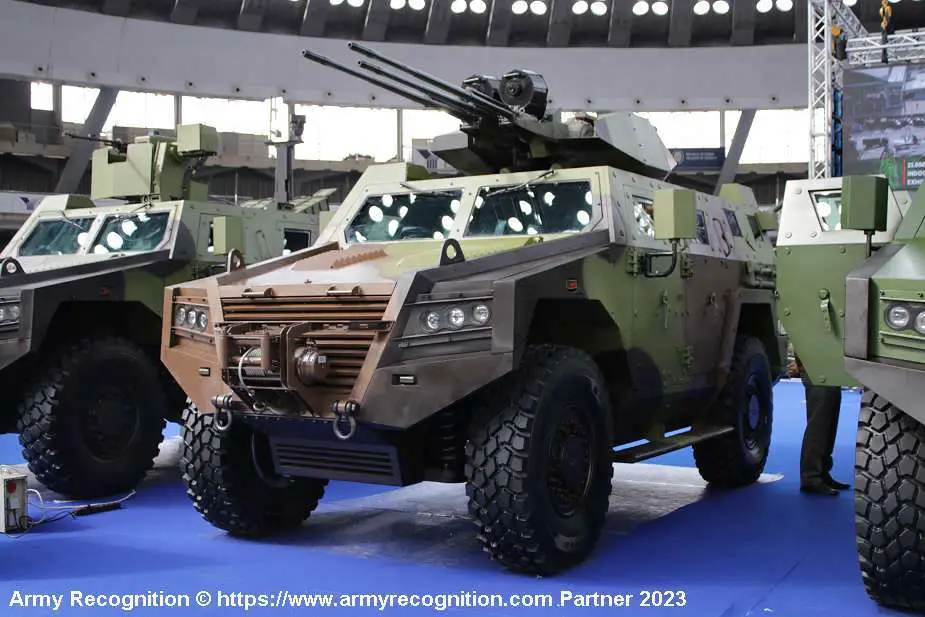Breaking news
Partner 2023: Yugoimport unveils Milosh BOV M16 4x4 armed with Kerber triple 20mm Remote Controlled Weapon Station.
Yugoimport, the Serbian state-owned defense company, unveiled a new variant of the Milosh BOV M16 4x4 multi-purpose armored combat vehicle at the Partner 2023 exhibition in Serbia. This version is equipped with the Kerber remotely controlled weapon station (RCWS), featuring a three-barrel 20 mm gun designed primarily for engaging a wide range of targets. The Kerber system was first introduced at the Partner 2019 exhibition and is an adaptable combat platform suitable for integration into combat vehicles (both wheeled and tracked), naval vessels, and stationary defense structures.
Follow Army Recognition on Google News at this link

The Milosh BOV 16 4x4 MRAP vehicle armed with the Kerber triple 20mm Remote Controlled Weapon Station at Partner 2023 (Picture source: Army Recognition)
The Kerber RCWS is capable of engaging ground targets, including weapon systems, mortars, machine guns, airborne troops, off-road vehicles, transporters, fuel trucks, trains, light armored vehicles, and enemy troops. It is also effective against seaborne targets, both mobile and stationary vessels, at distances of up to 2,000 meters. Additionally, it can address airborne threats such as slow low-flying aircraft, helicopters, drones, UAVs, and cruise missiles, with a range extending up to 1,500 meters.
One notable feature of the Kerber system is its rapid firepower delivery, boasting three 20 mm guns with a firing rate ranging from 1,950 to 2,250 rounds per minute. These guns are equipped with motors featuring electromagnetic brakes and zero-backlash gear reducers, ensuring accurate targeting.
The Kerber RCWS consists of essential components, including the weapon station itself. This station features a low-profile design and comprises a bottom gun carriage affixed to the vehicle's roof plate, an upper carriage with elevating components like a gun cradle and a sensor unit, and an armored hull made of steel that provides protection against 7.62 x 39 mm rounds and artillery splinters. Inside the hull, key components include motors, gear reducers, spare drums (3 pieces), an SPTA (spare parts, tools, and accessories) box, and a protective tarpaulin. The rear section of the hull includes four 82 mm smoke pot launchers for battlefield smoke generation and camouflage.
Operation of the Kerber system is managed through a control console with a Fire Control System (FCS), operated by a gunner within the host vehicle. The control panel features a joystick and a ballistic computer, along with push-button controls for sensor selection (LRF, day and night channels), gunfire selection (middle barrel, two lateral barrels, or all three barrels), and operation of four smoke pot launchers.
The ballistic computer serves as the central processing unit, equipped with software to assist the gunner in effectively managing the Kerber system. The computer's display provides critical data, including target distance, round status in each drum, magnification, and more.
The sensor unit is an integral part of the Kerber system, comprising a day channel, a night channel equipped with a thermal imaging camera, and a laser range finder. The day channel features a 1/2.8" CMOS sensor with variable magnification (36x wide to 2.3° tele). The night channel employs a 640 x 512 VOx Microbolometer sensor, operating within a spectrum range of 7.5-13.5 μm and offering a field of view from 6.2° to 5°. The laser range finder operates at a wavelength of 1540 nm and provides a measuring range of 80 to 10,000 meters with a measurement error of ±5 meters.
Regarding technical specifications, the Kerber system measures 1600 x 800 x 4400 mm (width x height x length) and has a weight of approximately 1000 kg with ammunition. It employs an electrical drive, offering a traverse field of action spanning n x 360° and an elevation field of action ranging from -5° to +70°. The automatic gun type used is the M55, featuring a caliber of 20 mm (20 x 110 mm) and a drum feeding system accommodating 60 rounds per drum, totaling 180 rounds.
The muzzle velocity is 850 m/s, with an effective range of 2,000 m and a rate of fire ranging from 1,950 to 2,200 rounds per minute. Additionally, the Kerber system is equipped with 82 mm smoke pot launchers for battlefield smoke generation, with drum replacement performed from the host vehicle, requiring approximately 1 minute for three drums.
The Milosh BOV M16 4x4, also known as the Milosh 4x4 multi-purpose armored vehicle, is categorized as an MRAP (Mine Resistant Ambush Protected) vehicle and is in active service with the Serbian Armed and Special Forces. Developed and manufactured by the Serbian defense company Yugoimport, the vehicle was initially unveiled at the International Defence Exhibition and Conference (IDEX) in Abu Dhabi, UAE, in February 2017.
The Milosh is constructed with a monocoque hull and a 4x4 chassis developed entirely in Serbia by Yugoimport. In its APC (Armored Personnel Carrier) configuration, it can transport up to 8 soldiers, including the driver and commander. The vehicle's suspension system features a T700 driveline developed by Timoney and Texelis, providing independent suspension for enhanced mobility across diverse terrains and weather conditions. The Milosh BOV 16 is powered by a 6.9-liter, six-cylinder Cummins ISB 300 diesel engine paired with an Allison 3500SP six-speed automatic transmission, enabling a maximum road speed of 110 km/h.


























